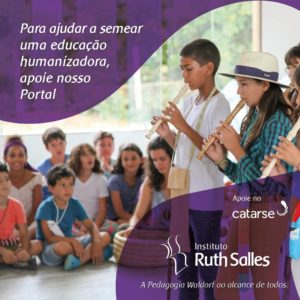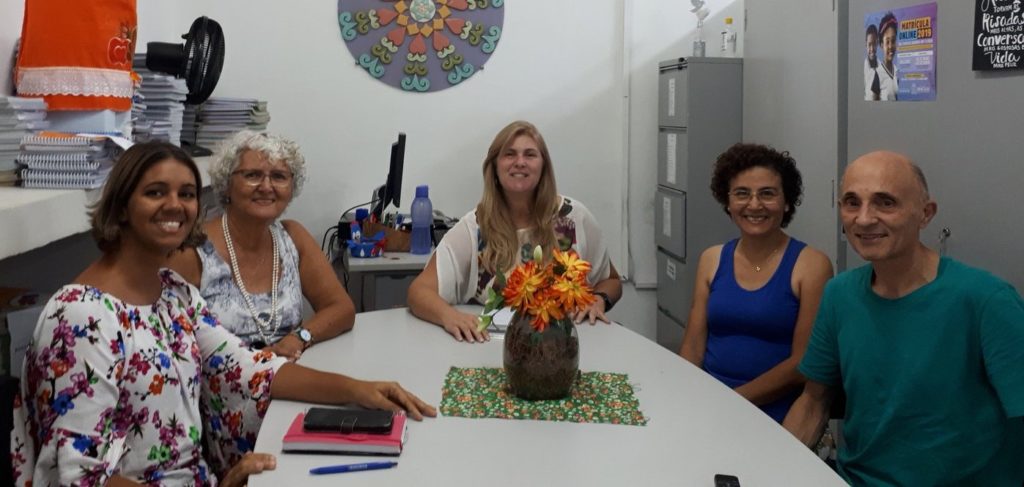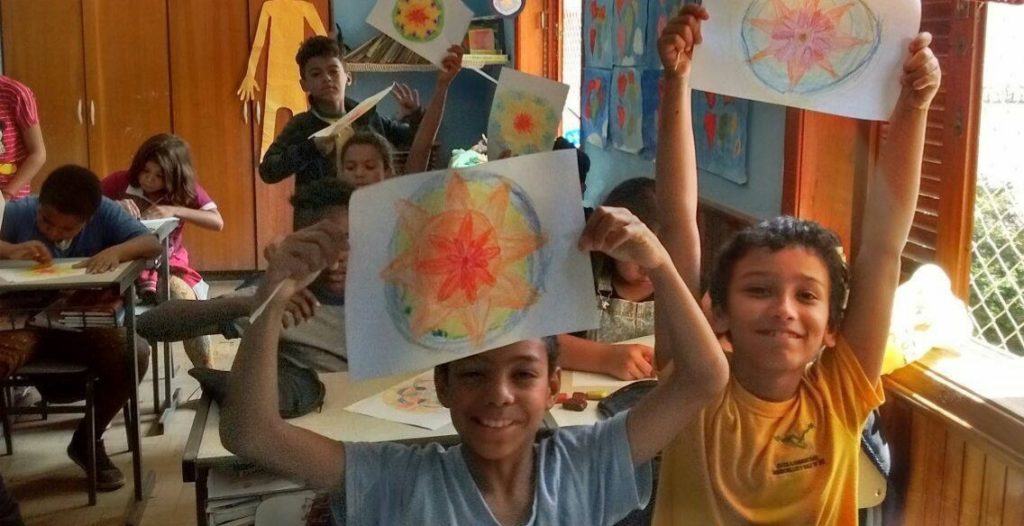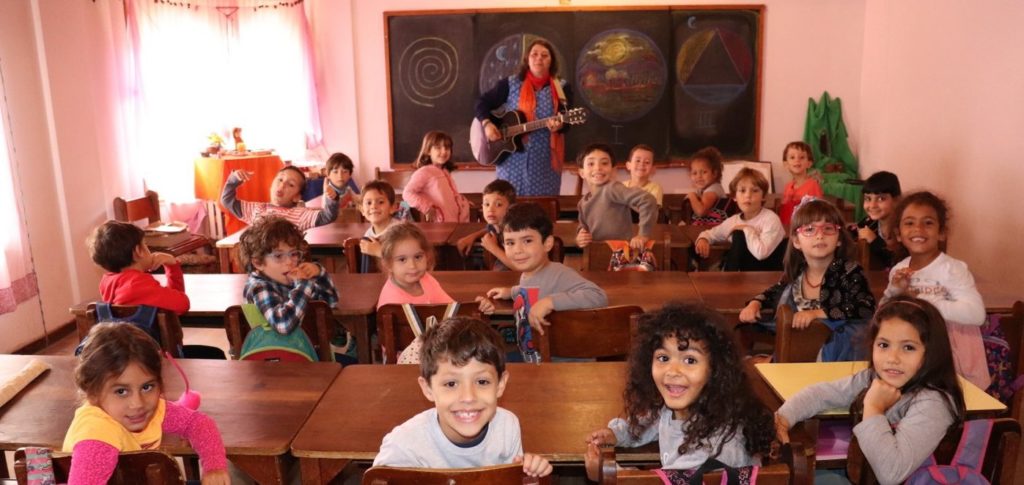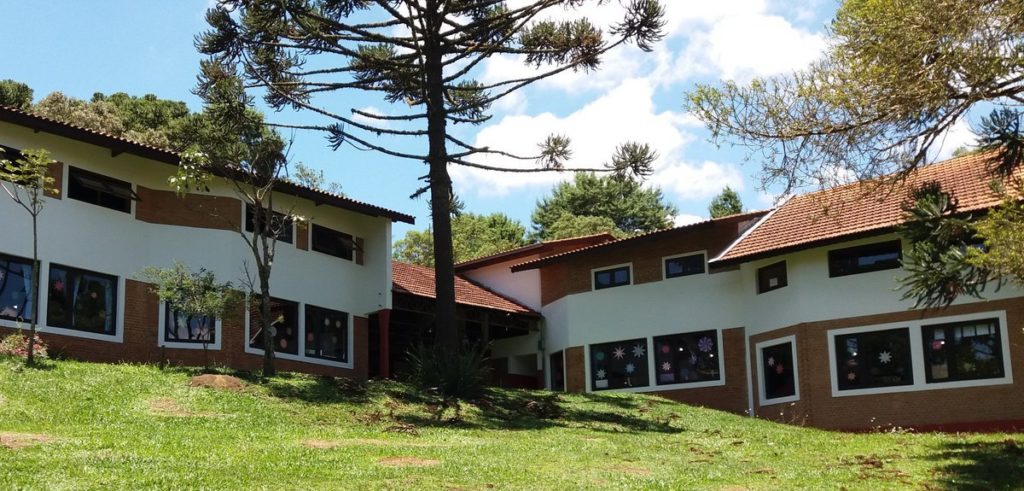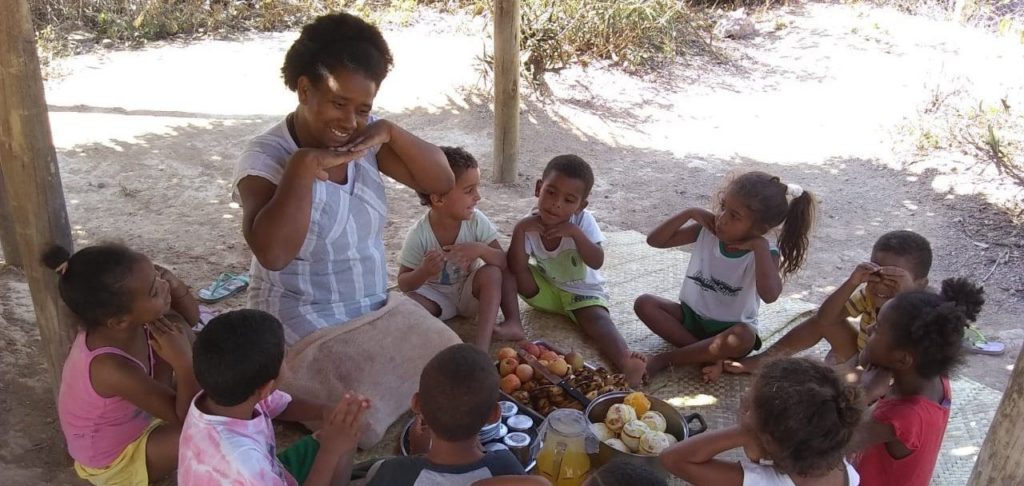The Waldorf Pedagogy
in public school
history – challenges – perspectives
by Rubens Salles and Rosineia Fonseca
Brasilia DF
TXAI movement
We arrived in Brasília on 04/28/2019 to get to know the Txai Movement, its activities in Brasília and at the Centro de Educação Infantil CEI 316 Norte, where education is inspired by Waldorf Pedagogy. We were received by Tereza Marques, then we had a meeting with other members of Txai, Luana Angélica and Eduardo Daniel, to talk and adjust the planning of our stay there. We stayed at the house of the couple Ana Paula and Bruno Vieira, parents of the school, who welcomed us with great sympathy.
highlights
1 – The Txai Movement is an excellent example of the determination of a group of teachers whose purpose is to take Waldorf Pedagogy to the public school system in the Federal District. The history of the movement shows a series of obstacles encountered along the way, which have been faced and have been overcome year after year since 2012, without the group losing track of its goals. Creating a public Waldorf school is always a long road, which requires a lot of will and dedication, the kind of strength that people truly committed to the common good have.
2 – When there is a collective movement of public school teachers who want to work with Waldorf Pedagogy, the chance of success is great. In this case of Brasília, the teachers of the Txai Movement, with the support of the school community, are transforming the school where they work into a school inspired by Waldorf Pedagogy, and there is the possibility of building a pilot school already planned to be a Waldorf School, in Regional Paranoá/Itapoã.
3 – As we have already seen happening in Nova Friburgo and Aracaju, the Txai Movement was also strengthened by acting in continuing education for teachers in the local public network, promoting an introduction to Waldorf Pedagogy and teaching the use of some of its elements. As a result, this pedagogy has become better known in the Federal District, and each teacher who participates in these courses and identifies with it, also helps to disseminate it and strengthens this current dedicated to humanizing education in Brazil.
4 – The courses for integral formation of Waldorf teachers need to become more accessible to public school teachers. They must be planned according to the availability of these teachers to participate, coinciding with the periods in which they can participate, and their costs must be subsidized for them.
Some basic data from the Federal District
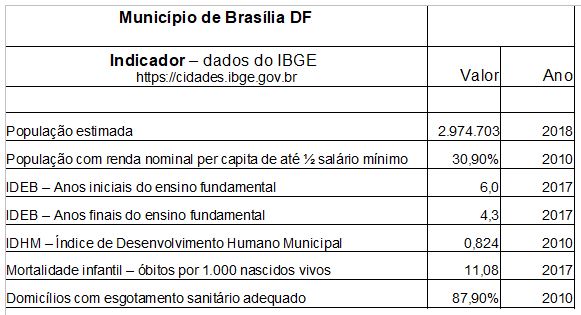
Address
SQN 316- AE
Contact: [email protected]
People interviewed
Txai movement
Luana Angelica Modesto Pimentel
Eduardo Daniel de Souza
Teresa Marques Cardoso da Silva
Erica Lobato
Daniela Alencastro
Milena Oliveira
Mary Josie de Souza Feitosa
Secretary of Education
Isac Aguiar de Castro – Regional Education Coordinator of the Paranoá/Itapoã Regional.
Paloma Tosatti – Pedagogical Advisor of the Teaching Regional of Paranoá/Itapoã.
Luciana de Amorim Halushuk – supporter – worked in the management of the Undersecretariat for Continuing Education for Education Professionals, and as an advisor in the Department of Education.
Humberto Farias – Director of Escola Classe 04 do Paranoá
Kindergarten CEI 316 North
Samantha Herrero – teacher
Fabiana Matoso – intern
Daviana Barros – mother and volunteer
Poliana Viana – mother
Juliana Solorzano – mother
School for the Improvement of Education Professionals
Luzia Lavendowski – EAPE student
The TXAI Movement
The Txai movement was created in 2012 at the initiative of Luana Angélica Pimentel, Tereza Marques and Cátia Soares (in memorian), professors with public service examinations at the Federal District Department of Education, who trained in Waldorf Pedagogy, also counting on a support nucleus formed by other teachers, friends and interested parties.
Today, as a result of seven years of work at Txai, 5 teachers trained in Waldorf Pedagogy, and 11 more who took an introductory course to Waldorf Pedagogy, work together at Centro de Educação Infantil 316 Norte, which serves 340 children in kindergarten. . Recently, the school's new Pedagogical Project, inspired by Waldorf Pedagogy, was approved by the General Assembly of the School Community.
Pedagogical Political Project 2019 – pdf
It has been a long journey up until this point, with many difficulties being faced along the way. In 2005 Luana Angélica Modesto Pimentel, the pioneer of the group, held a seminar on Waldorf Pedagogy, and told us that she was invited to work at the Moara school, but her impulse was really to work in the public school.
Luana – I was invited to work at Moara, because Moara grew fast and whenever they needed teachers they called me. And I said: “Guys, but now that I have learned something great, am I going to leave the public school boys without this thing that is already in the elite and will I continue to distribute the best slice of the pie to the elite? This social abyss that exists in Brazil requires attention.
Then, from 2012, the movement grew with the adhesion of other teachers who attended the Waldorf seminar, and began to look for ways to make a Waldorf public school in Brasília viable, as Luana, her husband Eduardo and Tereza Marques told us.
Luana – We call people connected with this subject, anthroposophists, psychologists. We had meetings every week. The group consisted of approximately twenty people, so we could find a way to implement Waldorf Pedagogy in the public network. Me, Tereza and Cátia started to do the project. Eduardo and Cláudia Dansa, then a professor at UnB, helped to write and we focused on Early Childhood Education. In three months we already had the project in hand and we took it to the Secretariat. We get there with the skeleton and they help. They said: “How beautiful to see a public school teacher wanting this!” Then, they helped us to better elaborate the project, in a way that the Secretariat understood, because it was going to pass in several instances.
Waldorf Garden Pilot Project – pdf
The Federal District published in 2012, and updated in 2018, its own curriculum, called Curriculum in Motion. There is a version for kindergarten and another for elementary school. Within the curriculum of early childhood education, there is talk of free play and contains several questions that fit the Waldorf Pedagogy. This served as justification in the presentation of the pilot project. A study comparing Waldorf Pedagogy and Curriculum in Motion was sent to the Secretary of Education at the time.
Curriculum in Motion - Early Childhood Education – pdf
ÇUrriculum in Motion - Elementary School – pdf
Edward – In 2013, we talked with the Secretary of Education, with the Child Education Board. In the design of this project, initially provided for the creation of this school and an action research project conducted by UNB on the pilot project. So the initiative would be born with this link with the university and the results would be evaluated by the university itself. We arrived with this project on a plate for the Government, which, while lacking implementation, is very suspicious when you present new things. In the course of the project, we identified these two facets. We would introduce it to someone, an authority who held a position, she was delighted with the proposal, but at the same time she said: "Look, it's difficult, I have this obstacle, I don't know how I'm going to put all the teachers in a unit only". Here in Brasília, the Public Power does not say where the teacher will work. There is a contest with scores, and you can move according to that score. One of the difficulties is: How are you going to allocate everyone to the same school?
This difficulty in allocating Waldorf teachers in a given public school is a problem that we found in all the municipalities we visited. We have not yet found any legal obstacle to holding a specific public tender for hiring trained or specialized teachers in this pedagogy, but we still do not know of any municipality that has done so. Only in the case of temporary hiring we have already seen notices that specify the specialization and experience in Waldorf Pedagogy.
Luana – The project passed in more than ten instances within the Secretariat. All of them liking it, approving it and saying: Pedagogically, it's all right, you can implement all this in the public network, but we don't have money. Then, a management passes, the election is lost and these people leave. In 2014 we returned to square one. We started presenting it all over again. A new government, which has also lost the election again…
Edward – As this path became very difficult, with many changes and interruptions, then they started this practical approach, of going all to the same school and starting from the base, from the practical functioning. Even so, they face a lot of resistance within the school itself. It's not a very simple path.
In Brasília, under current legislation, the director of each school is elected by the school community every three years, and families, teachers and school employees have the autonomy to define the school's Political and Pedagogical Project. Thus, it is possible for the school community to transform a school into a school inspired by Waldorf Pedagogy, in a democratic way.
Before being able to establish themselves in CEI 316 Norte, the group went through other schools, where conditions did not favor the project. In 2016 they started to teach at Escola Classe Natureza, but at the end of the year the teachers involved in the project were unable to remain because they did not belong to the school’s official staff. In 2017, they taught at Escola Classe Varjão, but it was a school with 40 classes, too large to be transformed into a Waldorf school, and kindergarten classes were abolished. One of the group's teachers, Amaiza F. de Sousa Medeiros, also taught at Escola Capão Seco. So in 2018 the group moved to CEI 316 Norte, which is a smaller school, just for kindergarten, and is located in the Plano Piloto of Brasília.
The group has the cabins and other natural materials suitable for the Waldorf kindergarten, a lot of things Eduardo made, and with each change of school they took all their “trousseau”. Today, at CEI 316 Norte, all classrooms have their own little cabins for children. The school serves children from the periphery, where there is a shortage of places and who take school transport, and middle-class children, many of whom are there because of Waldorf Pedagogy.
tereza – It cannot be just those who have money that can have access to this pedagogy, students from public schools also have the right to have access to this beautiful thing that is pedagogy. Hence the name Txai*. At first it was supposed to be a pilot school built, with direction, with everyone working in this pedagogical line, with the same name as Waldorf Pedagogy, because here in Brasília there are already pilot projects that work with a philosophical line with which people identify. We are now at 316 North, and it is the first school where we are having families participate. It started a small thing, this is the second year that we are in this school, and the amount of families that are looking for the school because of Waldorf Pedagogy is wonderful. project of us going to high school. I think the garden is just a beginning, but I believe, I don't know if I'll see it, but I'll work until the end of my days to make it happen. And that it's not just in the DF, and that it's not just a school. Although the political moment is contradictory, I feel the strength of so many people wanting it, these young people and children are looking for it. This pedagogy has been around for 100 years, but if we look closely, we are just getting started. What Steiner brought is very great for us to experience this to the fullest, but the Waldorf Pedagogy project in public schools, I believe we will be able to reach high school.
* TXAI means, in the language of the Kaxinawá Indians, from Acre, “more than a friend, more than a brother, the half of me that dwells in you, the half of you that dwells in me”
Watch the full interview
During this period of pilgrimage in search of making possible the implementation of a Waldorf public school in Brasília, the opportunity arose for the group to start teaching continuing education courses for public school teachers on the introduction to Waldorf Pedagogy, and also on elements of this pedagogy, with theoretical and practical approach.
Edward – In 2015 I was in these meetings to implement our pilot project. At a certain point, he has an audience with the Secretary of Education and he says the following: “How am I going to implement a school, if I have no training and the teachers are not trained? You have to offer courses.” So, despite the resistance, a gap opened up that brought into the EAPE (School for the Improvement of Education Professionals) a chair dedicated to Waldorf Pedagogy.
Luana – This Secretary was new. We had meetings with senators, district representatives, federal representatives. We were having meetings until we got a meeting with the Secretary of Education. So we asked and he said: “The project is beautiful, but I don't have the money to build your school. You train teachers, you only have nineteen and that's very little for a school. You will need at least twenty-five trained teachers.”
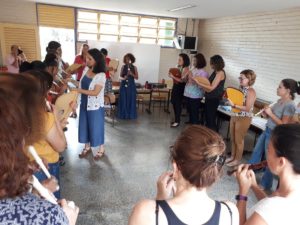
Course on elements of Waldorf Pedagogy at the School for the Improvement of Education Professionals.
The movement has already promoted several Waldorf Pedagogy courses for public school teachers, through EAPE, both introductory courses to Waldorf Pedagogy and on elements of pedagogy. We had the opportunity to participate in an afternoon of class in one of these courses, on 04/30/2019.
tereza – The movement had a professor from UNB – University of Brasília, Cláudia Dansa, who facilitated the creation of a university extension course on Waldorf Pedagogy at UNB. Now there's Sandra who also teaches that discipline there and Donald too. She supports, but did not attend the seminar. She makes room in her class for us to organize and teach the class there, art, theory, because we have more experience to teach Waldorf Pedagogy, because we did the seminar. In her last course, we had a meeting with her, along with Karla Neves, to help elaborate what it would be like.

Luciana de Amorim Halushuk
During this period, in search of making a Waldorf public school viable, the group had the support of some people working in the public area. One of them was Luciana de Amorim Halushuk, who has worked for 24 years in the public network in the DF, and worked at the Undersecretariat for Continuing Training for Education Professionals and as an advisor at the Department of Education. Luciana and Luana met as mothers at the Waldorf Moara School. As she was already familiar with Waldorf Pedagogy, having even worked with singing therapy in the care of young people in conflict with the law, Luciana helped create the first Introduction to Waldorf Pedagogy course at EAPE and helped the group in its relations with the Department of Education.
Luciana – One difficulty that I see when we talk institutionally about Waldorf Pedagogy within the public network is the issue of secularism. One of the great demands that we have today in the Federal District Government, in terms of management, is to ensure that Waldorf Pedagogy has no connection with a certain religion, with certain spiritual beings, separating religion from religiosity. Last year the girls had a lot of problems at school in this matter of religion, of ritual. They were even persecuted, because there were many evangelical teachers at the school and they believed that lighting a candle, telling the story, putting out the candle, all that was a profane ritual. So they started a series of persecutions with them there and I was able to act institutionally to alleviate the situation. We had to call the school principal, make an intervention. But that was only possible because I knew pedagogy. I'll help like this, from where I am.
As the Waldorf Moara School has been operating in Brasília since the year 2000, there is already a little more knowledge about this pedagogy in the region and about Anthroposophy, which allows finding more people who know and can give their support to the main objective of Txai, of to set up a public Waldorf school. However, pedagogy still needs to be much better known for it to be more easily accepted.
Luciana – Today I am on a board of quality of life and well-being at work. So, I take pedagogy into my work, I've done several activities and people ask. What is it? Where does it come from? I am in a retirement preparation program, where I take singing therapy. Then they ask: Who created it? Answer: Rudolf Steiner. I'm rescuing and talking about Waldorf Pedagogy. We've been going around the edges a lot, but institutionally we still don't have the structure to work with.
Today, the Txai Movement has four fronts of action. One is CEI 316 North, where they currently teach. Another is the courses given at EAPE (School for the Improvement of Education Professionals), which take place during working hours and teachers receive scores and a certificate. There is also the UNB extension course, and the pilot project of an entire school, to be built for Waldorf Pedagogy. According to Luana, an average of 13, 14 people participate in Txai meetings.
Watch this VIDEO Luana Angélica presenting her work at Jardim da 316 Norte
Daniela Alencastro – Txai movement
Daniela has been part of Txai for a long time, has been a teacher at the network for 7 years and is currently the Pedagogical Coordinator at CEI 316 Norte. This position is elective by the faculty themselves annually. In this video, she talks about the relationships with the school's parents, about the challenges faced and also talks about the use of Social Pedagogy in the social organism that is the school.
Watch the full interview
When they taught at Escola Classe Natureza, which is located in the administrative region of Paranoá, the work carried out by the teachers of the Txai movement enchanted some people, among them Isac Aguiar de Castro, Coordinator of the Regional Teaching of Paranoá. Isac was responsible for the construction and implementation of a school to work with the Escola da Ponte method, developed by José Pacheco and which was inaugurated in 2018. He now intends to also implement a school inspired by Waldorf Pedagogy, from the pilot project of the Txai movement.
Interview with Isac Aguiar de Castro
Regional Education Coordinator
Isaac – I was in several events, several programs and several classes there at Escola do Capão Seco, and we saw how happy the children were studying that way, living in that everyday space that Waldorf Pedagogy brings to children. So, what I could extract from the contact I had with the children: They were much more comfortable in the school space, they felt an integral part. The way they circulated between the school spaces was very interesting, it seemed that they were more appropriate in the physical space than the other children in regular regular education. We got to know a school that develops Waldorf Pedagogy in the private sector, the experience was also very interesting, through the advisor Paloma. We have had this contact with Waldorf Pedagogy since 2015 and since then we have been working, but not as consistently as we wanted. We have an innovative proposal to create a school that will meet this expectation, not only of this group of professionals, but ours and our community, to present them with a new education option. Our community needs this. So, I think that this Waldorf Pedagogy proposal has a lot to add to our reality today, especially in early childhood education and elementary school I.
Watch the full interview
In order to prepare teachers to work in a new school, which Isac plans to build in the administrative region of Paranoá/Itapoã, the Txai Movement group intends to carry out a training course in the region itself, starting in 2020.
Interview with Paloma Tosatti
Guidance counselor
Paloma has been an educational advisor at the Regional de Ensino do Paranoá for 11 years and also had the opportunity to get to know and follow the work of the teachers of the Txai movement. She was the advisor when the group worked at Escola Classe Natureza and told us how she got to know Waldorf Pedagogy.
Paloma – The arrangement of the tables was different, the way of telling the story was different. That started to pique interest. "What is happening? How does that work?” They began to explain the whole process, the routine and we began to notice a difference in these children. The look of these children was not the same as the others, their interaction, the respect between them, the respect for the teacher. That thing from the old days when you idolized your teacher we don't see today, and the students looked at the planters as if they were goddesses in their lives, they had a lot of respect. As a counselor, I noticed a very close relationship with those families, because the teachers treated these families differently. It wasn't that formal parenting meeting, reading a report, talking about where your child is doing well, where he's not, where he's evolved, where he hasn't. It was different. The care for these families was different. They felt more welcomed and they were closer to the school, even though it is a rural area with not so easy access, we noticed that these families were more open to dialogue than those of the other classes.
Watch the full interview
Interview with Humberto Farias
Director of the Paranoá Class 04 School
Humberto is Paloma's husband, and acted as Coordinator at Escola Classe Natureza when the teachers from the Txai movement taught there. He told us how he got to know Waldorf Pedagogy and Anthroposophy.
Humberto – In 2015 I was working at the nature class school, which is in the rural area of Paranoá, and teacher Cátia arrived there. She performed Waldorf Pedagogy, but did not say that it was Waldorf Pedagogy. I remember that the circle games, the ciranda, the rescue of our childhood caught my attention. I remember that I thought it was really cool to see her play with the boys from Corre Cutia, who we don't see anymore. In 2016, Luana, Maisa, Daniela arrived and effectively implemented Waldorf Pedagogy in the initial grades. I was in coordination. I had a certain distance at first, because we were analyzing each other. Will it work? There was a lot of resistance from the management because the way of working is very different. And then, little by little, we got to know the girls, we started talking and we started to like Waldorf Pedagogy. Maisa told me about Anthroposophy, so I went to study Anthroposophy. And I remember that I told Maisa once: “Maisa, I didn’t know there was a science that summarized everything I believe in.” Then I read some texts, some books on Anthroposophy. I went to UNB, did the extension course, then I went to Germinar, which was very interesting. We learn to manage ourselves, and Germinar is based on Anthroposophy. I say that it was God who took me there. It was in 2017. And I applied here a lot of what I saw in Germinar. There was Madalena who taught the course at UNB reporting some of her experiences. I told her like this: “That doesn't exist, that doesn't happen, you're saying that to convince me.” She said: “Humberto, it exists, it works and one day we are going to start a course. And it's impressive! I am enchanted by Anthroposophy. Of course I have questions. I also have questions about Waldorf Pedagogy, but it needs to reach the masses. You can't stay in a corner, because if it was bad, the elite wouldn't be there. How is it that you who defend Pedagogy and are unable to place your children? For me, this is inconceivable. Do as the girls from Txai did, drop by drop, until you take care of the whole thing. This I think is important.
Interviews with teachers and mothers from CEI 316 North
Interview with Milena Oliveira – Txai Movement
Milena – I got to know Waldorf Pedagogy in my last year of college. My husband studied with me in college and he knew Waldorf Pedagogy. He was the father of students at the Moara school and spent many years studying anthroposophy. He always talked and everyone was curious. I asked a lot of questions and he took me to visit Moara, the oldest Waldorf school here in Brasília. I was very delighted because as a student, I was already in the process of doing internships. We saw theory in college and when we arrived in the classroom to accompany the teachers, it was all different from what we heard. I saw many traditional practices, very ingrained, without looking at the child. So when I saw that school, I said, “There is salvation!” That was the area I chose. It was a breath of fresh air in my heart. I did the training and finished last year. Then I met the girls from the Txai movement. We got together to study, to look for ways in which this could happen. We wrote the project, we went to present it in several instances, in several bodies, in Congress, with the deputies, I was in this movement with them. They started in Paranoá and in 2017 they came to Escola Classe Varjão and I joined them. It was very special to experience this strength of the group.
Interview with Mary Josie de Souza Feitosa – Txai Movement
Josie has a degree in History, is studying pedagogy and has been doing Waldorf training since January 2018. She has already completed six modules of the 16 that the course has. He works in the administrative region of Ceilândia, on the outskirts of the Federal District, at a final grade school and works in the Comunidade do Sol Nascente, a large favela in Brasília. It is a very large region that does not have a final grade school and students have to travel.
Josie – It is a beautiful, interesting, captivating path, and I feel that my practice as an educator has greatly improved. I learned a lot of things. And, being in that place of student again is important for those who are teaching. We understand again what the learning process is like. For me, it has been a rich moment of life. Of course, I find some problems in training and in practice, which I think we need to overcome together, but I thought it really enriched my training as a teacher, as an educator. I feel like a much better professional than I was before I met him. It is contributing in a very positive way.
One thing that I found positive here in Brasília, both in the Txai and José Pacheco movements, is that they are teachers' initiatives, not a state initiative. José Pacheco's was inaugurated last year. They already had a study group with a professor from UNB who brought him to participate. It's called Autonomy Forum. There is this issue of the LDB itself, which defends the pedagogical, administrative and financial autonomy of schools.
An important issue raised by Josie was the difficulty that public school teachers in the Federal District have to attend the training seminar at Waldorf Pedagogy. This course is taught in four annual immersion meetings, and only one of these meetings coincides with a vacation period for these teachers. She informed us that in the current class, which has more than 40 students, only 5 or 6 teach in the public network. There is still another problem: this course is not recognized by the Department of Education.
Josie – This course is not recognized by the Department of Education for a waiver. Within our career plan, we can ask for a license to participate in congresses, seminars, courses, and when the course is recognized by the MEC, by the Department of Education, this can happen. Currently, the coordination of the seminar has proposed to formalize the course to see if we can get this resource.
Interview with Daviana Barros – mother of a student at CEI 316 North
Daviana has a degree in Art Education, is in the 5th class of the Waldorf training seminar in Brasília, and is studying pedagogy, taking a supplementary course, and intends to work as a teacher in the future.
Daviana – It is wonderful for us to know that Waldorf Pedagogy can be in the public network and have this space, an open discourse on the part of the government for this reception. But we also know that it is a confrontation with a system that already exists, with an idea accepted by most people who work in education in the state. So, it's a challenge every day […] Today there is already a more open dialogue, there is already greater harmony, and we feel that we still have a way to go, but that we know that every Waldorf school has.
Watch the full interview
Interview with Professor Samantha Herrero
Samantha has been a public school teacher for six years, and got to know Waldorf Pedagogy at Escola Classe Varjão in 2017, where she had the opportunity to work with some members of the Txai Movement. She then started to get information with her colleagues and read several books to learn a little about Anthroposophy and Waldorf Pedagogy. Today he works with the CEI 316 Norte group and is taking the course at EAPE.
Samantha – From then on, education started to make more sense to me, because I saw the being in its entirety, and as I was with a small baby, everything I put into practice, I looked at my baby, and it made sense with those experiences. I thought this is the way now I should go. Waldorf Pedagogy came to me as a gift, as a mother and as a professional too, and from that year on I decided to go in search of what makes the most sense to me
Watch the full interview
Interview with Poliana Viana - student's mother
Poliana already knew Waldorf Pedagogy, as her eldest son was a student at Escola Moara, and now she has enrolled another son at CEI 316 Norte because she knew there were teachers from the Txai Movement working there.
poliana – My middle child also needs to have this experience of pedagogy, of being in a Waldorf school, of being able to experience this, and, even more beautiful, in a public school, where he has access to this diversity of children and realities.
Watch the full interview
Interview with Juliana - student's mother
juliana “We joined 316 here at the end of last year and it's been a wonderful experience. The Waldorf inspiration brings a more humanistic look to the child, the look that the child has to have, the self-discovery, of the perception of the world, and bringing this together with the diversity of the public school has been a wonderful experience. My daughter came from a private school, and I couldn't perceive this fusion of society as possible, with its diversities and differences, complemented by such an extraordinary, human look that brings to the child a perception of the whole, within what she realizes. So the storytelling, the involvement with the ciranda, the issue of colors, the perception of textures, all this is very rich and has been extraordinary for my daughter's development. And realizing that it is possible to bring this to the most diverse social strata, and that these parents also identify themselves, even if they don't know the philosophy, even if they don't know that they have a study behind them, is very wonderful.
Watch the full interview
Interview with Fabiana Matoso – intern at CEI 316 North
fabian – I think it would be very interesting for students to get to know Waldorf Pedagogy, because in the academic world we rarely talk about Waldorf Pedagogy. We hear that they have Waldorf schools but, really, we don't know how a Waldorf school works, we don't know about the theory and ideas that Rudolf Steiner had. So I find it very interesting, as a Pedagogy student, before speaking or criticizing, or suddenly moving away, trying to get to know a little, trying to get closer, reading, trying to know some schools that practice to see what makes sense. Sometimes you can incorporate it into your practice, even if the school you work at is not a Waldorf school, you can incorporate it into your practice as an educator.
Watch the full interview
Erica Lobato – Txai Movement
Érica was already the mother of a student at CEI 316 Norte before the Txai Movement teachers started teaching there.
Erica – I already knew Waldorf Pedagogy, I already came from a Waldorf associative garden, and I managed to take some elements of Waldorf Pedagogy, such as storytelling, inside the school, with dialogue with the management and coordination of the school, such as storytelling, I managed to do a workshop on the Easter with the school teachers. At that moment, the school's pedagogical advisor went to EAPE to take the Waldorf training course, which she ended up not being able to complete, but I felt that at that moment I was supporting planting a little seed there at the school. At the same time my son entered school (2017), I met the Txai movement, which was in another school at that time. They inspired me a lot. I always looked for support with them, they brought me materials to study, stories to take inside the school. (The Txai Movement arrived at the school in 2018) […] I was fortunate enough to spend a year still at school, having the Movement there. My son stayed with teacher Milene and it was a very prosperous moment for my work, because there was a segment within the school with whom to dialogue, which I imagine is an ideal environment for children and also for families.
Watch the full interview
Lucia Lavendowski – EAPE student
Luzia is a public school teacher in the Federal District, an early grade pedagogue, and got to know Waldorf Pedagogy in 2016 through a course at EAPE, taught by the Txai Movement team.
Lucia – I had already heard about Waldorf Pedagogy, I had already read about Rudolf Steiner, but there was nothing concrete, it was not part of my repertoire. But, from the year I started the course, it was like a watershed, it was when I discovered something that I had been looking for my whole life and didn't see resonance in the places. So, when I had the first contact, the resonance was very strong inside me, and then I discovered: This is what I want for myself. I took the training course (at EAPE) in 2016, 2017, 2018, and this year 2019 the girls invited me to be part of the team as a collaborator. And in the meantime, the training course in Waldorf Pedagogy appeared here in Brasília, which I started a year ago, I am part of class 5. So, in 3 years it hit so hard that I am already doing the training, and I am already managing to apply some thing at the school where I work, which is not a Waldorf school.
Watch the full interview

